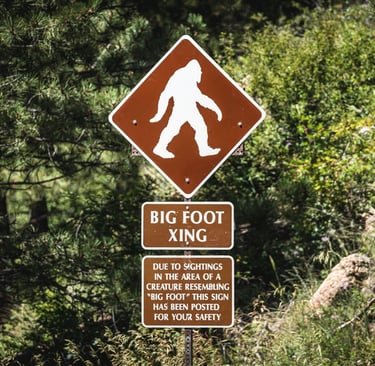
Episode 7 - Bigfoot
Episode 7 - Bigfoot - Blog about the show, make sure to check us out on your favorite podcast platform!
PARANORMAL
Daniel



Bigfoot
The figure of Bigfoot—a towering, hairy, bipedal creature lurking in the wilderness—is one of the most enduring icons of the unknown. But this modern legend is deeply rooted in ancient traditions, eyewitness accounts, and a scientific debate that continues to rage to this day.
The Ancient Roots: Indigenous Legends
Long before the term “Bigfoot” entered the popular lexicon, Indigenous tribes across North America told stories of similar creatures, weaving them into their cultural and spiritual understanding of the natural world.
The Sts’ailes People: The very name “Sasquatch” is anglicized from the Halq’eméylem word “Sasq’ets” used by the Sts’ailes people of British Columbia. To them, the Sasq’ets is a powerful, supernatural “wild man” of the forest, a protector to be respected and feared, embodying the sacred and untamable spirit of the wilderness.
The Algonquin Tribe: Algonquin folklore speaks of the Mishipeshu, or “Water Panther,” a powerful, dragon-like creature that rules the water and is sometimes linked to tales of large, mysterious forest beings due to its size and elusive nature.
The Cherokee: Cherokee mythology includes Tsul ‘Kalu, a giant, hairy, supernatural being with immense strength and a mischievous nature that lives in the mountains. It is described as a great hunter and a master of stealth, often compared to Bigfoot.
These ancient narratives provide a rich cultural tapestry that suggests the concept of a large, mysterious hominid has been part of human consciousness for centuries, far predating modern hunting stories.
The “Smoking Gun”: The Patterson-Gimlin Film
The Bigfoot phenomenon exploded into mainstream consciousness on October 20, 1967, when rodeo rider Roger Patterson and his friend Robert Gimlin filmed a brief, shaky piece of footage in Bluff Creek, California. The roughly 60-second film shows a large, muscular, fur-covered creature walking bipedally across a creek bed before disappearing into the trees.
The Patterson-Gimlin film instantly became the most hotly debated piece of evidence in cryptozoology.
Proponents, like Idaho State University anatomy professor Dr. Jeff Meldrum, argue the film shows convincing biological details—a seamless muscle structure under the fur, a non-human gait (a “bent-knee, bent-hip” locomotion), and a crest on the head that doesn’t correspond to any known costume of the era.
Skeptics, such as filmmaker Phil Poling, maintain it is an elaborate hoax. They point to the suit’s perceived awkwardness, the commercial availability of similar suits in the 1960s, and inconsistencies in Patterson and Gimlin’s story.
Despite decades of analysis, the film remains an enigma—neither definitively proven real nor conclusively debunked.
A History of Hoaxes
The search for Bigfoot has been persistently plagued by hoaxes, which have severely damaged the credibility of the field.
The Ray Wallace Hoax (1950s): After his death in 2002, Ray Wallace’s family revealed he was the creator of the famous wooden “Bigfoot feet” used to create tracks in the Pacific Northwest in the 1950s, discrediting a wave of early footprint discoveries.
The Minnesota Iceman (1968): A traveling exhibit featured a “Bigfoot corpse” frozen in a block of ice. It was later revealed to be a cleverly crafted latex model, though it continues to be displayed as a curiosity.
The Tom Biscardi and Rick Dyer Hoaxes (2005-2014): These serial hoaxers repeatedly claimed to have captured or killed a Bigfoot, once even presenting a frozen body that was later revealed to be a rubber suit. Their schemes culminated in a failed 2014 tour where they promised, but never delivered, scientific proof.
These incidents have created a “boy who cried wolf” dynamic, making it difficult for legitimate evidence to be taken seriously.
The Ape Canyon Attack: A Legendary Encounter
One of the most dramatic and well-documented early encounters occurred in July 1924, when a group of five prospectors—Fred Beck, Hank, Marion Smith, Smith’s son, and a man named Larsen—were stalked and besieged in their cabin on the slopes of Mount St. Helens.
The men reported days of eerie prelude: finding massive, isolated 19-inch footprints and hearing unnerving whistles and chest-thumping sounds echoing through the canyons. The confrontation culminated one night when their remote cabin was violently attacked by what they described as multiple “ape-men,” who pelted the structure with rocks and tried to break down the door. The terrified miners fought back with their rifles, firing through the walls and roof. At one point, a hairy arm reached through a gap and grabbed an axe before being driven back by a gunshot.
At dawn, the attack ceased. As they fled, Beck claimed to have shot and hit one of the creatures, watching it fall into a deep gorge. Despite an investigation that found rocks around the cabin and photographed large tracks, no body was ever recovered. The miners stuck to their story for the rest of their lives. Decades later, Fred Beck published a booklet suggesting a more metaphysical explanation: that the creatures were interdimensional beings, manifestations from a “lower plane” of consciousness. Whether a straightforward animal encounter or something stranger, the Ape Canyon attack remains a foundational and chilling tale in Bigfoot lore.
The Scientific Pursuit: DNA and dedicated Researchers
Despite the hoaxes, several groups and individuals continue to pursue Bigfoot with a scientific approach.
The Bigfoot Field Researchers Organization (BFRO): Founded by Matt Moneymaker, the BFRO maintains the largest database of sighting reports and conducts organized field investigations.
Dr. Jeff Meldrum: A professor of anatomy and anthropology, Meldrum is one of the few academics to seriously study the phenomenon, focusing on the analysis of footprint casts and biomechanics.
The Melba Ketchum Controversy (2012): Geneticist Melba Ketchum made headlines by claiming her five-year DNA study proved Bigfoot was a human hybrid. However, her research was widely denounced by the scientific community for its methodological flaws and its publication in a questionable journal she herself created. The episode became a cautionary tale about the need for rigorous peer review.
Conclusion: An Enduring Icon of the Unknown
The mystery of Bigfoot endures because it taps into a deep, fundamental human fascination with the unexplored corners of our world. Is it a undiscovered primate, a cultural archetype, a series of misidentifications, or an elaborate modern myth?
The lack of definitive physical evidence—a body, a clear photograph, or irrefutable DNA—keeps mainstream science firmly skeptical. Yet, the sheer volume of sighting reports from credible witnesses and the persistence of the legend across cultures and centuries suggest that something continues to capture our imagination. Whether a literal creature or a powerful symbol of the wild, Bigfoot remains a permanent and compelling fixture on the border between known reality and the thrilling possibility of the unknown.


